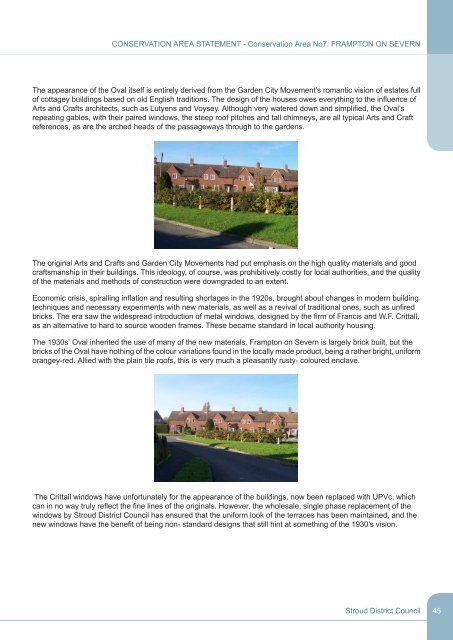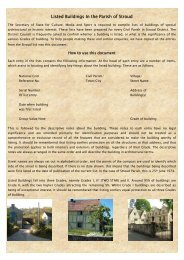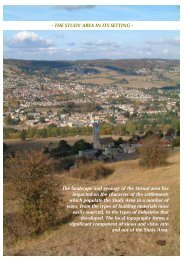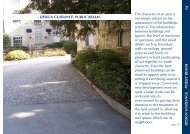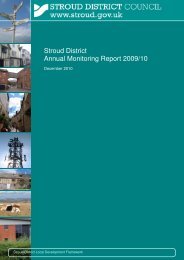CONSERVATION AREA STATEMENT - Stroud District Council
CONSERVATION AREA STATEMENT - Stroud District Council
CONSERVATION AREA STATEMENT - Stroud District Council
You also want an ePaper? Increase the reach of your titles
YUMPU automatically turns print PDFs into web optimized ePapers that Google loves.
<strong>CONSERVATION</strong> <strong>AREA</strong> <strong>STATEMENT</strong> - Conservation Area No7: FRAMPTON ON SEVERN<br />
The appearance of the Oval itself is entirely derived from the Garden City Movement’s romantic vision of estates full<br />
of cottagey buildings based on old English traditions. The design of the houses owes everything to the influence of<br />
Arts and Crafts architects, such as Lutyens and Voysey. Although very watered down and simplified, the Oval’s<br />
repeating gables, with their paired windows, the steep roof pitches and tall chimneys, are all typical Arts and Craft<br />
references, as are the arched heads of the passageways through to the gardens.<br />
The original Arts and Crafts and Garden City Movements had put emphasis on the high quality materials and good<br />
craftsmanship in their buildings. This ideology, of course, was prohibitively costly for local authorities, and the quality<br />
of the materials and methods of construction were downgraded to an extent.<br />
Economic crisis, spiralling inflation and resulting shortages in the 1920s, brought about changes in modern building<br />
techniques and necessary experiments with new materials, as well as a revival of traditional ones, such as unfired<br />
bricks. The era saw the widespread introduction of metal windows, designed by the firm of Francis and W.F. Crittall,<br />
as an alternative to hard to source wooden frames. These became standard in local authority housing.<br />
The 1930s’ Oval inherited the use of many of the new materials. Frampton on Severn is largely brick built, but the<br />
bricks of the Oval have nothing of the colour variations found in the locally made product, being a rather bright, uniform<br />
orangey-red. Allied with the plain tile roofs, this is very much a pleasantly rusty- coloured enclave.<br />
The Crittall windows have unfortunately for the appearance of the buildings, now been replaced with UPVc, which<br />
can in no way truly reflect the fine lines of the originals. However, the wholesale, single phase replacement of the<br />
windows by <strong>Stroud</strong> <strong>District</strong> <strong>Council</strong> has ensured that the uniform look of the terraces has been maintained, and the<br />
new windows have the benefit of being non- standard designs that still hint at something of the 1930’s vision.<br />
<strong>Stroud</strong> <strong>District</strong> <strong>Council</strong><br />
45


